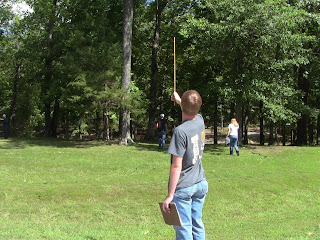Saturday we had torrential rain, Sunday was cloudy and damp, but running off, and Monday was glorious. We had great field conditions for the students and kept them busy all afternoon. We set up the Compass and Pacing course first thing, then Timber Measurement, Tree ID, Equipment ID, and Silviculture. The students also had to take a general knowledge test and a test on map interpretation. It is a real workout for the kids and a few always excel. Everyone learns, and I bend the rules and coach the ones that don't have a clue what they are doing. That way they learn a bit and they may do well next year. Olney took first, and Fairfield was second. Olney will be going to the state contest at Carbondale on Saturday. Here are a few photos of the activities.
Bonus measurement info that I provide to students, or anyone else who needs to measure tree height:
Measure Log Length With Any Straight Stick
Biltmore sticks are usually set up for a 25” reach on the
tree diameter scale and the Merrit Hypsometer, and many of us do not have a 25”
reach. Using the Merrit Hypsometer
requires that you pace out one chain (66 feet) from the tree, and many of the students
I see do not understand pacing, so they throw a lot of error into the
equation. There is an alternate method
that lessens the errors, but the student must still concentrate on pacing
accurately and keeping good form with a stick.
Much of the upland timber we work in will run from 1 ½ to 2 ½
logs in length. Instead of 66 feet, pace
out 32 feet (2 logs) from the tree and turn around. Your eye is now 32 feet from
the tree. Roll your head back and keep
it motionless while measuring. Extend
the hand holding your stick so it is up to eye level. Bring the top end of the stick back with your
other hand so the stick comes to the corner of your eye. Raise the stick to vertical position, roll
your eye to the stump level of the tree and lower your hand with the stick so
the top of your hand is in line with the stump (Approx, 1 foot from the ground
or less, usually). Hold your head motionless and roll your eye up to the top of
the stick. It will be lined up to show
you 32 feet up on the tree, or 2 logs.
If your cutoff point is no more than 8 feet above that, it is a 2 log
tree. If the cutoff point is no more
than 8 feet below it, you have a 1 ½ log tree.
Because you often will have a 2 log tree, you can see what ½ of that is
and add it to the top of your stick in your head and see if you have a 3 log
tree. If the timber is running taller
than a 2 log average, make your distance 40 (2 ½ logs) or 48 (3 logs).
This method saves a great deal of time in pacing and the 25”
reach of the stick is irrelevant. Check
your pace frequently so you can nail that distance and you will do a good job
of measuring the merchantable height.
Check your diameter measurements with your Biltmore Stick against a Diameter Tape so you will know how
your stick actually measures for you.
Bonus Info: You can also measure very close to the exact
height of vertical objects with a
stick. Holding your stick vertically
with your head back, move in or out from your object until the stick matches up
with the top or the cutoff point. Pace
in to your tree, wall, smokestack, or whatever you are measuring. Now you know the height. This method is also valuable to see if a tree
will strike an object that you don’t want to strike, such as a power line.
Stand at the power line and set up your stick. If the object (tree, silo, smokestack) is
standing taller than your stick, it will hit you. So Easy it should not be legal.
PS: I just heard from Olney. They took first place at the Monticello Sectional and their five team members were all in the top ten.















No comments:
Post a Comment